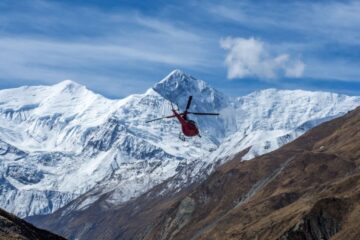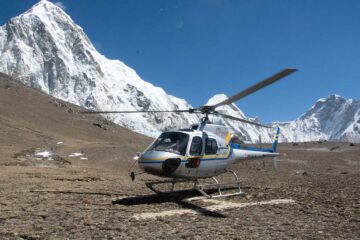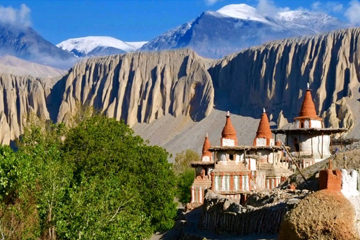This Everest Base Camp Trek with helicopter return is for those short in time, but who want to see Everest up close without sacrificing any highlights. The hike starts from Lukla and follows the classic Everest base camp reaching to Kala Patthar viewpoint. From Gorakshep, you will take a helicopter return to Kathmandu.
The 11 days Everest Base Camp Trek with Helicopter Return is specially designed for the adventure lovers who have time limitation or short vacation and can afford any price for adventure and euphoria.
It is the combo package to experience the adventure, mystified nature, gigantic snow-capped mountains, and cerulean landscape in a comfortable manner. The trip offers hypnotizing aerial view of the world’s highest peak, Mt. Everest (8,848m), various massifs, glaciers, rivers, rivulets, and entire 360° view from the sky of the Himalayan region.
Highlights of Everest Base Camp Trek with Helicopter Return
- Flying above the mighty Himalayas from Kathmandu to Lukla.
- A thrilling yet scenic helicopter ride from Gorakshep to Kathmandu.
- One of the world’s highest airports at Syangboche.
- Familiarise with Sherpa traditions and lifestyles.
- Explore world-famous monasteries and museums in the Khumbu region.
- Trek in an incredible landscape around the world’s highest peaks, Mt. Everest (8,848m), Mt. Lhotse (8,516m), Cho Oyu (8,201m), and Mt. Makalu (8,463m).
- Encounter wildlife like musk deer, snow leopard, and Himalayan tahr.
- Traverse through the highest glacier on Earth (Khumbu Glacier)
Best Time To Do Everest Camp Trek With Helicopter Return
The best time to do the Everest Base Camp trek depends on various factors, including weather conditions, visibility, and crowd levels. Generally, the two primary trekking seasons for Everest Base Camp are the pre-monsoon (spring) season and the post-monsoon (autumn) season. Here’s a detailed breakdown of each season:
Spring Season (Pre-Monsoon)
-
- Months: March, April, and May
- Weather: Generally stable with mild temperatures during the day and cold temperatures at night. Clear skies and excellent visibility.
- Landscape: The trail is colorful with blooming rhododendron forests.
- Crowd: High season with a relatively large number of trekkers.
- Highlights: Vibrant landscapes, pleasant weather, and potential mountaineering expeditions on Everest.
Autumn Season (Post-Monsoon):
- Months: September, October, and November
- Weather: Generally dry with stable temperatures during the day. Cold temperatures at higher altitudes but warmer than spring. Clear skies and excellent visibility.
- Landscape: Beautiful views with clear skies and stunning autumn foliage.
- Crowd: High season with a significant number of trekkers but less crowded compared to the spring season.
- Highlights: Clear views of the surrounding peaks, favorable weather, and festive atmosphere (Dashain and Tihar festivals).
It’s important to note that although these are the primary trekking seasons, the Everest Base Camp trail can be trekked throughout the year. However, the winter months (December to February) and the monsoon season (June to August) are generally less popular due to extreme cold, snow, and higher chances of rainfall, respectively.
When planning your trek, it’s advisable to consider your preferences for weather conditions, crowd levels, and personal fitness. Additionally, make sure to check with local trekking agencies or guides for up-to-date information on trail conditions, permits, and any potential changes.
Everest Base camp Trek With Helicopter Return/Packing List
When embarking on an Everest Base Camp trek with a helicopter return, it’s important to pack wisely to ensure you have the necessary gear for the trekking portion and for a comfortable helicopter ride back. Here’s a packing list that covers the essentials:
- Clothing:
- Moisture-wicking t-shirts
- Long-sleeved shirts
- Fleece jacket or down jacket
- Waterproof and windproof jacket
- Insulated pants or trekking pants
- Base layer (thermal underwear)
- Waterproof and breathable trekking pants
- Warm hat and gloves
- Hiking socks and liner socks
- Trekking boots and comfortable shoes for camp
- Equipment:
- Backpack (40-50 liters) for trekking
- Daypack for carrying essentials during the day
- Sleeping bag (rated for sub-zero temperatures)
- Trekking poles
- Headlamp with extra batteries
- Sunglasses (with UV protection)
- Sunscreen (high SPF) and lip balm
- Water bottle (at least 2 liters) or hydration bladder
- Trekking towel
- Personal Items:
- Toiletries (toothbrush, toothpaste, biodegradable soap, etc.)
- Personal medication and first aid kit
- Wet wipes or hand sanitizer
- Quick-drying towel
- Insect repellent
- Small pocket knife or multitool
- Cash (Nepalese rupees) and identification documents
- Miscellaneous:
- Camera or smartphone for capturing memories
- Portable power bank for charging devices
- Travel adapter and charging cables
- Duct tape for quick fixes
- Snacks (energy bars, nuts, etc.)
- Waterproof bags or dry sacks for keeping items dry
Remember to pack as light as possible since you’ll be trekking at high altitudes, and it’s essential to carry only the essentials. Additionally, check the weather forecast before your trip and adjust your packing list accordingly.
It’s always a good idea to consult with a professional trekking guide or agency for a more personalized and updated packing list based on your specific needs and preferences.
Physically And Meltally Preparing
Preparing for the Everest Base Camp trek requires both physical and mental readiness. Here are some guidelines to help you prepare for the journey, considering your plan to return by helicopter:
- Physical Fitness:
- Start with a baseline level of fitness: Engage in regular physical activities such as walking, jogging, cycling, or swimming to improve your cardiovascular endurance.
- Focus on strength training: Include exercises that target your legs, core, and upper body to build strength and endurance. Squats, lunges, planks, push-ups, and shoulder presses are beneficial.
- Increase endurance: Gradually increase the duration and intensity of your workouts to build stamina. Consider incorporating long hikes or stair climbing into your routine.
- Altitude training: If possible, engage in activities that simulate high-altitude conditions, such as hiking at higher elevations or using altitude training equipment.
- Consult a healthcare professional: Before undertaking any rigorous physical activity, consult your doctor to ensure you are in good health and receive personalized advice.
- Trekking Gear and Equipment:
- Invest in high-quality trekking gear: Purchase or rent appropriate trekking gear, including sturdy hiking boots, moisture-wicking clothing, thermal layers, waterproof jacket and pants, warm hat, gloves, sunglasses, and a backpack.
- Test your gear: Prior to the trek, try out all your equipment, especially your footwear, to ensure they are comfortable and don’t cause blisters or discomfort.
- Pack wisely: Carry essential items such as a first aid kit, water bottle, headlamp, trekking poles, sunscreen, and snacks. Avoid overpacking to keep your backpack lightweight.
- Mental Preparation:
- Research and educate yourself: Learn about the trek, its challenges, and the region’s culture. Familiarize yourself with altitude sickness symptoms, prevention, and treatment.
- Set realistic expectations: Understand that the Everest Base Camp trek is physically demanding, and altitude can be challenging. Be prepared for long hours of walking and possible weather variations.
- Mental resilience: Develop a positive mindset and mental resilience to overcome challenges during the trek. Focus on small milestones and celebrate achievements along the way.
- Learn basic Nepali phrases: Learning a few basic Nepali phrases can help you interact with locals and enhance your experience.
- Acclimatization:
- Acclimatize gradually: Give your body time to adjust to the increasing altitude by incorporating rest days during the trek. Ascend slowly, following the recommended acclimatization guidelines.
- Stay hydrated: Drink plenty of water throughout the trek to combat dehydration. Avoid excessive caffeine and alcohol consumption.
- Recognize altitude sickness symptoms: Be aware of the symptoms of altitude sickness, such as headache, dizziness, nausea, and difficulty breathing. Inform your guide or trekking companions if you experience any concerning symptoms.
- Helicopter Return:
- Understand the logistics: Familiarize yourself with the helicopter return process, including the cost, availability, and booking procedures. Be prepared for possible delays or schedule changes due to weather conditions.
- Be flexible: Keep in mind that helicopter services are subject to weather and operational constraints. It’s essential to maintain flexibility and be prepared for potential adjustments to your plans.
- Stay safe: Follow all safety instructions provided by the helicopter company and maintain caution during the flight. Listen to the pilot’s guidance and be mindful of safety procedures.
Accommodation:
If you’re looking for accommodation options during the Everest Base Camp (EBC) trek and planning to return by helicopter, here are some details to consider:
Accommodation during the EBC Trek:
- Tea Houses/Lodges: The most common form of accommodation along the EBC trek is tea houses or lodges. These are basic guesthouses located in villages along the trail. They provide rooms with beds, blankets, and sometimes shared bathrooms. Tea houses also offer meals and snacks, making them convenient for trekkers.
- Camping: If you prefer a more adventurous experience or want to trek during the off-season when tea houses might be closed, you can choose camping. You’ll need to carry your own camping gear or hire a trekking company that provides camping equipment. Keep in mind that camping may require additional permits and arrangements.
Helicopter Return from EBC: If you plan to return from Everest Base Camp by helicopter, you have a few options:
- Private Helicopter Charter: You can hire a private helicopter to fly you back from Everest Base Camp to Kathmandu or Lukla, depending on the availability of landing spots. This option offers flexibility in terms of departure time and allows you to customize your itinerary. Private charters are more expensive but provide a faster and more comfortable return.
- Shared Helicopter Flights: Another option is to join a shared helicopter flight. This involves sharing the helicopter with other trekkers who are also returning from Everest Base Camp. Shared flights are more affordable than private charters but may have limited availability and fixed departure schedules.
It’s important to note that helicopter flights from Everest Base Camp are subject to weather conditions and availability. It’s advisable to make arrangements in advance through a reputable trekking agency or helicopter operator. They can assist with booking accommodation, arranging helicopter flights, and ensuring a safe and smooth return from EBC.
Remember to check the latest information and regulations regarding trekking permits, helicopter operations, and COVID-19 guidelines from the appropriate authorities in Nepal before planning your trip.
Day 01: Arrival in Kathmandu and transfer to hotel.
Upon arriving in Kathmandu, you will be welcomed and transferred to your hotel. Take some time to relax and prepare for your upcoming adventure.
Day 02: Flight to Lukla and trek to Phakding (or Manjo)
Catch a scenic flight to Lukla, situated at an altitude of 2,820 meters. From there, embark on a trek to Phakding (or Manjo) at an elevation of 2,657 meters, which takes around 4 hours.
Day 03: Trek to Namche Bazaar
Continue your trek, heading towards Namche Bazaar at 3,440 meters. The journey takes approximately 6 hours, and you’ll stay in a cozy tea house.
Day 04: Rest day at Namche Bazaar
Take a day to rest and acclimatize in Namche Bazaar. You can explore the town, visit local markets, and enjoy the surrounding scenic views.
Day 05: Trek to Tengboche (or Tyangboche/Deboche)
Resume your trek, heading towards Tengboche (or Tyangboche/Deboche) at an altitude of 3,867 meters. The trek takes around 5 hours, and you’ll spend the night at a tea house.
Day 06: Trek to Dingboche (or Pheriche)
Continue your trek to Dingboche (or Pheriche) at an elevation of 4,365 meters. The journey takes approximately 5 hours, and you’ll stay in a tea house.
Day 07: Rest day at Dingboche
Take another day to rest and acclimatize in Dingboche. You can enjoy a local hike, explore the area, and soak in the breathtaking mountain views.
Day 08: Trek to Lobuche
Resume your trek and head towards Lobuche at 4,890 meters. The trek takes around 5 hours, and you’ll spend the night at a tea house.
Day 09: Trek to Everest Base Camp and return to Gorakshep
Today, you’ll trek to the iconic Everest Base Camp at 5,365 meters. After spending some time there, you’ll return to Gorakshep at an elevation of 5,180 meters. The entire journey takes about 6 hours, and you’ll stay in a tea house.
Day 10: Climb Kalapathar and fly back to Kathmandu by Helicopter
Early in the morning, embark on a challenging ascent to Kalapathar at 5,545 meters to witness a breathtaking sunrise view over Mount Everest. Afterward, you’ll be flown back to Kathmandu by helicopter.
Day 11: International departure
It’s time to bid farewell to Nepal as you embark on your international departure, taking home unforgettable memories of your Everest Base Camp trek.
International and domestic pick up and drop off by private car/Jeep/ Hiace.
2 night hotel accommodation with breakfast (B/B) in Kathmandu
All necessary papers including Everest national park permit and TIMS card (Trekking Information Management System)
Meals on a full-board basis (Breakfast, Lunch, and Dinner/ the main course) during the trek in the mountain.
Nature View Trek’s experienced, government-licensed, English-speaking trekking guide.
Gorak shep to kathmandu return on helicopter.
All salary, food, drinks, accommodation, transport, and insurance for the guide.
Trekking equipment such as the Sleeping bag, and down jacket on request (optional)
Trekking lodges (Tea House) throughout the trek
Airfare from Kathmandu – Lukla – Kathmandu.
Seasonal fresh fruits are desert every evening after dinner.
Appreciation of certificate after the successful trek.
Farewell Dinner at a typical Nepalese restaurant with traditional music and dance
Oximeter to measure your oxygen and Pulse level during the trek in the mountain.
Compressive first aid box (Guide will carry it throughout the trek).
Emergency rescue operation assistance in arranging in case of complex health conditions (funded by your Travel Insurance)
All government, Local taxes/ vat, and official expenses
Nepal entry Visa fees
Lunch and Dinner while in Kathmandu(2 days)
Kathmandu Sightseeing Tour
Your Travel Insurance
International Airfare and Airport Tax
Your Travel Insurance
All Drinks.
Personal things like postage, a hot water, internet, and laundry
Tips for guide & porter





Tour Reviews
There are no reviews yet.
Leave a Review